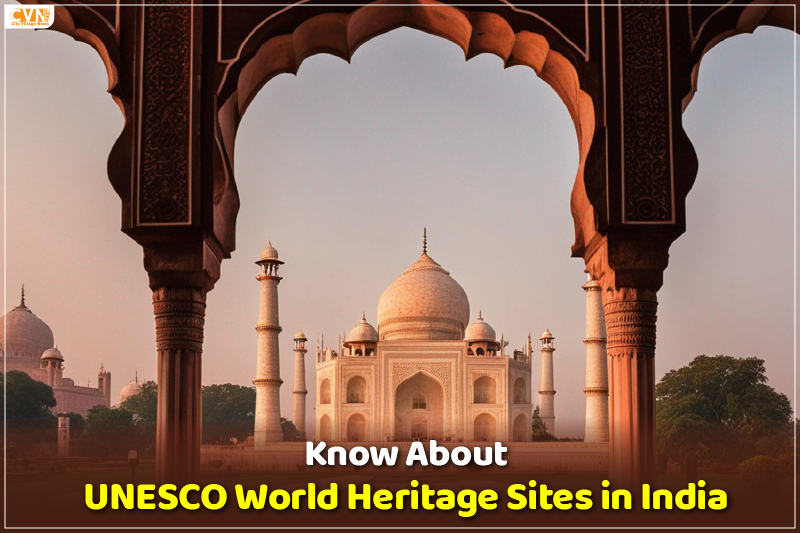India is a treasure trove of cultural and natural heritage. The incredible country is home to several sites that have been declared globally significant by the United Nations Educational, Scientific, and Cultural Organization (UNESCO). The different stories of India’s many civilizations, rich history, and stunning landscapes are captured in this diverse culture. The fact that UNESCO recognized these locations emphasizes how crucial it is to protect them to guarantee their survival for future generations. The magnificent natural landscape of the subcontinent and the architectural marvels of bygone dynasties make these cultural sites important. India provides an opportunity to experience these treasures personally and immerse oneself in a millennium-long legacy for visitors.
There are nearly 42 UNESCO World Heritage sites in India at present. From the tropical vegetation of the south to the snow-capped Himalayas of the north, these are spread throughout the country. In terms of UNESCO World Heritage sites, India is ranked sixth in the world. These iconic sites showcase the diversity of its culture and languages.
Check Out the Top 10 UNESCO World Heritage sites in India.
1.Taj Mahal, Agra:
Not only an architectural masterpiece but also a symbol of love. The Taj Mahal is undoubtedly the most famous UNESCO World Heritage site in India. The stunning beauty of this white marble mausoleum, built by Emperor Shah Jahan in honor of his wife Mumtaz Mahal, attracts millions of tourists each year.
2. Qutub Minar, Delhi:
The Qutub Minar, a 73 m red sandstone and marble tower in the capital city, was built in 1193 by Qutb-ud-din Aibak following the fall of the last Hindu monarchy in Delhi.
3.Jaipur City, Rajasthan:
Jaipur also known as the “Pink City,” was listed as a UNESCO World Heritage Site due to its architectural legacy. It represents a combination of Mughal and provincial Rajput cultures.
4.Khajuraho Group of Monuments, Madhya Pradesh:
Known for its intricate carvings and sculptures, these temples honor the human form and its elegance and are an iconic representation of the Chandela dynasty’s architectural talent. There are six heritage sites in Madhya Pradesh that you can visit during your trip here.
5.Red Fort Complex, Delhi:
The Red Fort, which acts as a powerful representation of India’s political story and its rich historical legacy, was the Mughal emperors’ royal home. Its majestic red sandstone walls and intricate Mughal design attract visitors from around the world.
6.Sundarbans National Park, West Bengal:
The largest mangrove forest in the world, Sundarbans spans across Indian and Bangladesh. It is popular for its unique ecosystem that includes a range of flora and fauna. This is a crucial natural habitat for Bengal tigers, in addition to being a UNESCO World Heritage Site.
7. Elephanta Caves, Maharashtra:
These rock-cut caves, which are near Mumbai on Elephanta Island, are home to numerous historic Shiva temples. The Hindu sculptures here date back to the 5th to 8th centuries. Elephanta Caves aptly showcases India’s rich cultural and religious history.
8.Great Himalayan National Park, Himachal Pradesh:
High mountain peaks, alpine meadows, and riverine forests define this park, which is a haven for adventurers and nature lovers alike.
9.Hampi, Karnataka:
Views of the Dravidian architecture and the history of the Vijayanagara Empire can be experienced from the magnificent ruins of Hampi. These are one of the top 10 UNESCO World Heritage Sites in India.
10.Chola Temples, Tamil Nadu:
Constructed by the Chola Empire’s rulers, these temples represent an outstanding example of Dravidian temple design and bronze artifacts from the 9th to the 12th century.
UNESCO World Heritage Sites in India are much more than the landmarks. They are the pieces of an enormous historical book that remain available to be perused and understood. An essential aspect of India’s cultural legacy, they narrate stories of love, power, devotion, and inventiveness. Are you planning a trip to India soon? For a truly unique trip into the core of India’s history, make sure to include these locations on your itinerary. Choose Indian Eagle flights to book your trip for an affordable travel experience to discover these ageless treasures.
Frequently Asked Questions
1. Which country has the most UNESCO World Heritage site?
With 58 sites each, Italy and China are tied for the most UNESCO World Heritage Sites. These include a wide range of natural, cultural, and mixed-heritage sites.
2. How many UNESCO World Heritage Sites are there in India?
India is home to 42 World Heritage Sites. 34 of these are cultural, 7 are natural, and 1 is a mixed kind, which is Khangchendzonga National Park. India ranks sixth globally in terms of sites.
3. Why Visit the UNESCO World Heritage Sites in India?
Visiting these UNESCO World Heritage Sites in India offers more than just sightseeing. Knowing the stories, myths, and history that have molded this country is a journey into the very core of understanding its culture. With the exhibits of India’s artistic, cultural, and architectural accomplishments over the centuries, each location provides an insight into the past.
| Disclaimer: City Village News claims no credit for the images featured on its blog site. All the visual content is copyrighted to its respective owners only. We mention the source name of the picture whenever possible and found. However, please get in touch with us if we miss acknowledging the owner’s source. In case the owners don’t want us to use their images, we will remove them promptly. We believe in providing proper attribution to the original author, artist, and photographer. |


